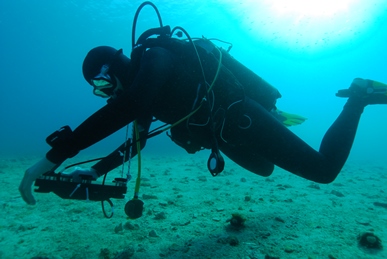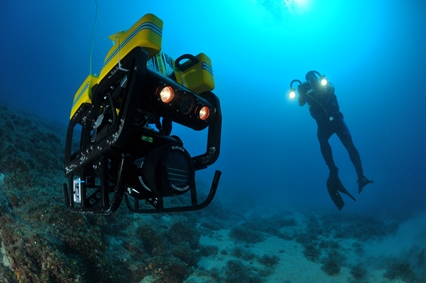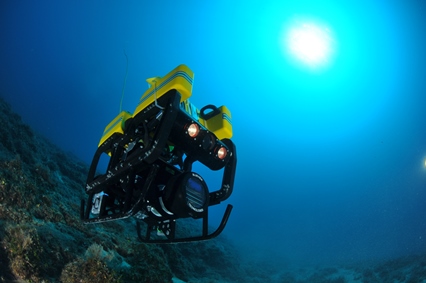Search & recovery mission (S&R)
Before an underwater mission starts, both the diver and the CADDY system are "informed" about the mission plan and procedures. The CADDY system will guide the diver through the mission. Specifically, the scenario is to search an area in a lawnmowing pattern and recover a specific object. With the CADDY system, there is no need to perform conventional rope laying on the sea bottom; instead, the buddy will guide the diver underwater. During the S&R mission, the autonomous buddy has to
i) follow the predetermined path,
ii) ensure that the diver is following the buddy, i.e. execute cooperative algorithms with switching leaders, and
iii) keep an appropriate distance to the diver at all times in order to ensure diver safety and enable interpretation of the symbolic hand gestures and the diver behaviour.
At any time the diver can stop the mission, change the mission parameters, or command the buddy to perform compliant tasks. During the validation scenario, the diver will test the cognitive abilities of the CADDY system, i.e. behaviour interpretation, symbolic gesture interpretation, and reactivity of the diver.



Underwater archaeology mission
The diver is led by the CADDY system directly to the place where the previous diver has stopped with the documentation of the underwater site. There will be no need for the conventional positioning of frames on the seabed. When at the exact location, the diver starts with the archaeological mission (i.e. documentation of the site). While on the site, the diver will use hand gestures to command the buddy to perform some required tasks such as take a photo of a part of the sea bottom, make a mosaic of an area, direct light to a specific part at the sea bottom, etc. to alleviate the burden on the diver during the execution of a strenuous operation. This set of tasks will be defined in the project.
At all times during the excavation mission, the autonomous buddy has to
i) attain optimal positioning with respect to the diver in order to ensure diver safety, enable interpretation of the symbolic hand gestures and interpretation of the diver behaviour,
ii) accurately interpret commands issued by the diver and comply with the tasks requested, and
iii) adapt the mission plan according to the diver’s instructions.
The execution of the validation tasks will be assessed by the members of the CADDY Advisory Board and DAN Europe by referring to the following key performance indicators:
- speed and success of diver behaviour interpretation;
- speed and success of the buddy reaction to a change in the mission plan;
- diver ergonomics – was the distance of the buddy appropriate during the mission?, was the diver safety area preserved during the mission?;
- precision of path following (for both the diver and the buddy) during S&R mission and precision of path following during the descent to the underwater archaeology site; and
- precision and compliance of the buddy operations during assistance to the diver.
Additional indicators may be defined by the Advisory Board members and DAN Europe if found necessary.